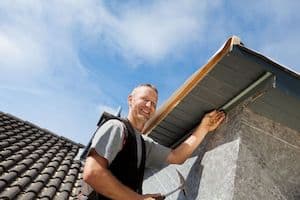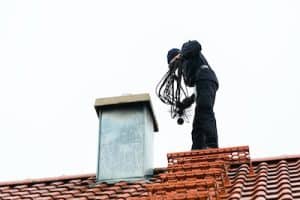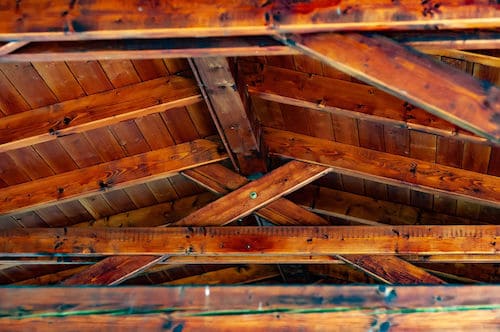There are some jobs that require you to climb on top of your roof, and when that happens, you want to be prepared. While climbing around at heights of 15 – 30 ft, you really don’t want to take risks when it comes to your safety.
If you are getting ready to tackle one of these jobs, you may find yourself asking this valuable question: How much weight can my roof hold?
Roofs are generally designed to withstand the combined weight of both live loads (which are temporary) and dead loads in order to ensure structural safety. After reviewing local building codes, the dead load for normal shingled or wooden roofs is a minimum of 20 pounds per square foot, while it’s closer to 27 pounds per square foot for a more sturdy material like a clay tile or metal roof.

Knowing this information can save you from wasting a lot of time, spending a lot of money and possibly even breaking some of your bones.
If the weight of the live load and the dead loads exceed their limitations, you could have a serious problem on your hands. But how do you know if you are in danger of this? Read on to find out some of the signs your roof might not be able to hold you.
How much snow can my roof hold?
Modern roofs can hold up to 10 feet of snow or 20 pounds per square foot.
Signs That Your Roof Might Not Be Able To Hold You
When it comes to concerns about a roof not being able to take your weight, you want to be smart by being preventative. Being preventative begins with being aware of the signs of potential compromise in structural integrity. Some of these signs include:
If Your Roof Is Sagging — One of the sure-tell signs of a dangerous roof is if you notice any sagging. An entire roof won’t give way all at the same time, so it’s really important to stay on the lookout for the beginning evidence of a potential collapse.
Things like bowing in the roofline or dips in the roof’s plane are clear indicators that there is a problem. If you start to walk on your roof and you notice that the areas underneath your feet are springy, spongy or soft, you need to get off of the roof immediately.
If You Notice Cracks In Your Ceiling Or Brickwork — If you are noticing cracks anywhere, it is a clear indicator that something is not right. Cracks in any brickwork can mean that it is being stressed by the roof because it is spreading in an outward direction.
Cracks in your ceiling mean that there is an underlying problem that can’t be seen with the naked eye, so you need to investigate as soon as possible.
If Your Roof Has A Leaking Problem — If you are seeing multiple leaks in your ceiling, it means that there is moisture being let into the structure of your roof, and this is a big issue. If water has been accumulating and has continued to sit over time, you can be certain that bowing and sagging in your roof is soon to come.
If You Hear Unusual Sounds Coming From Your Roof — When examining your roof, and especially when walking on it, you want to be very careful to stay alert to any sounds that aren’t in the norm. Unfamiliar creaking, squeaking or moaning coming from your ceiling could mean that you may be seeing the inside of your house soon, so climb down immediately and assess the situation.
If Your Roof Has Weather Damage — Weather can have an extreme effect on your roof if it goes unchecked. The accumulating of heavy snow can leave the roof weakened and even vulnerable to unwanted moisture, and this can lead to some big-budget issues. If your roof has sustained any exposure to intense weather, make sure to take that into consideration before making the climb up to your roof.
If You Notice Abnormalities In Your Home — You know your home best, so it’s great to use that to your advantage when considering the integrity of your roof and how much weight it can hold. If you notice things that are off or different in your home, it could be a sign that there are structural problems.
Things like slanted floors, unfamiliar drafts, uneven surfaces or soft spots in the floor can all be evidence that your roof could not be safe to walk on. Observe these changes closely before walking on your roof.
How To Reinforce Your Roof To Be Stronger
If your roof is really old or has already experienced a lot of damage, you probably need to look into a full replacement or build a new roof, to ensure structural integrity. However, there are a few preventative steps you can take to reinforce the roof to handle more weight and withstand more strain than it would normally be able to.
1. Attach The Trusses To The Walls — One action step you can take to strengthen your roof is to attach the trusses to the walls using hurricane tie-downs. You will only be able to do this in certain places because it is sometimes difficult to access certain points of the roof’s interior structure.
You might be able to get more access in the attic, interior walls or soffit panels. Once the trusses are attached, you will have a much more sturdy roof.
2. Repair Damaged Shingles With Construction Adhesive — Asphalt shingles are the most common type of roofing material, and they usually do their job well. Sometimes, however, you might need to repair damaged shingles or ones that have curled up or chipped after years of use.
Using construction adhesive to glue down any unstable portions will ensure that any unwanted moisture will stay out of your roof, therefore protecting it from inevitable rotting issues in the future.
Long term, making sure these kinds of problems are taken care of will give you a stable, long-lasting roof that you will have no problem walking on if needed.
3. Strengthen Existing Trusses — Strengthening your existing trusses is an easy way to gain even more durability in your roof. Using 2x4s, simply combine them with the existing trusses from one end of your house to the other.
Doing this is really important if you want to provide more overall stability for any kind of additional or abnormal weight load on top of your roof.
How To Walk On Top Of Your Roof Safely
 Once you have ensured that the structural integrity of your roof is safe and secure, walking on top of your roof is now a possibility. While walking on your roof may seem like a piece of cake, this isn’t always the case.
Once you have ensured that the structural integrity of your roof is safe and secure, walking on top of your roof is now a possibility. While walking on your roof may seem like a piece of cake, this isn’t always the case.
As a result of homeowners taking matters into their own hands and not learning about the proper safety measures to take, there are around 130,000 accidents each year. In the construction industry alone, around one-third of all fall-related injuries are a result of falling from roofs.
That’s why it is extremely important to learn what is safe and what isn’t when it comes to walking on your roof safely. Some of the ways you can do this are by:
Safety Tips:
Look Before You Walk — It may sound obvious, but this is an easy one to miss. Sometimes, homeowners are so eager to get onto their roof, they don’t take any time to observe what they are about to step onto. There could have been recent rain, snow or even dew that can make your roof extremely dangerous to step foot on. If you have checked out your roof beforehand and you are still concerned, don’t rush it. Either bring a towel with you to dry the roof, or wait for the roof to dry out on its own.
Wear The Proper Footwear — When climbing on your roof, you want to make sure you are wearing the right kind of footwear. On slants like these, flip flops or crocs aren’t going to cut it. In this kind of situation, you want to be wearing shoes that have rubber-tracked soles and will give you the proper traction that you need. Rubber is always better when dealing with deeper slants.
Wear Appropriate Safety Gear — If you are dealing with a single level home, you are probably fine to go without a ton of additional safety gear. If you are planning on a home with two or three levels or that has steep slopes, you most definitely want to make sure you have the appropriate safety gear for the job.
Using a safety harness system is crucial when dealing with this type of steep roof because short slips can otherwise result in quick and sudden falls.
Watch Out For Greenery — When walking on top of your roof, you want to be on alert for any algae or moss that could be growing in small patches. If there are some of these patches, you want to be sure to avoid walking on them. Both of these types of greenery are able to trap moisture and create a surface with very little traction.
If algae or moss has grown on the entire roof, you will want to take a few small test steps on the material while being secured safely. It may need to be completely cleared off before you are able to climb on your roof safely.
Get Rid Of Unwanted Debris —
Over time, unwanted debris is able to accumulate and can become a hazard for you as you are climbing higher on your roof. Be sure to clear any sticks, trash, pine needles or leaves away before you begin your ascent.
 Tips For Walking On Different Roofing Materials:
Tips For Walking On Different Roofing Materials:
How To Walk On Asphalt Shingles — When deciding to walk on an asphalt roof, make sure that you are wearing footwear that is able to give you good traction on the shingle’s surface. After making sure the roof is structurally sound, you want to inspect the roof visually before trying to take your first steps. If you see any tears, curls, rips or damaged shingles, try your best to avoid stepping on them and find an alternate path. Be sure to use small, intentional steps and don’t be afraid to lay a roofing ladder across the roof to help you gain access if it’s too steep.
How To Walk On Concrete Tiles — Walking on concrete tiles is not recommended, because they are not designed to handle the extra live load. Any extra weight will potentially cause them to crack or loosen and this can cause more problems in the future. If you aren’t able to avoid walking on your roof, make sure that you transfer your weight evenly and try walking on the balls of your feet.
You want to make sure your footwear is able to get good traction and avoid leaping from one tile to the next. Because of the way the clay tiles are installed, the most sturdy portions to step on are the lower third section of the tile that is visible.
How To Walk On Wood & Clay Tiles — Wood and clay tiles are very popular and have an extremely beautiful appearance, but are designed mainly to withstand years and years of exposure to the sun and other weather elements.
Because of this, they are easily damaged because they are so brittle, and will crack if you aren’t careful. If one of these tiles is damaged, it will leave your home exposed to moisture problems in the future. Try to avoid walking on these materials, and call a professional instead.
How To Walk On Metal Roofing — Metal roofs today are rustproof, leakproof, and require little to no maintenance. While this is the case, there may be a few situations when you need to get on top of one, and you want to make sure you do it safely.
After examining the roof on the outside and inside for any visible concerns, you will want to extend your ladder in a safe place and then stay on or near the rafters to have the most stable foundation when walking. You will be able to recognize you are standing on a rafter because it will feel very solid.
We hope you have found this information helpful as you are considering climbing on top of your roof. Knowing how much your roof can handle is crucial information to know before making your first efforts. If you have any more questions or want to gain more knowledge about how much weight your roof can handle, contact your local roofing contractor today!

